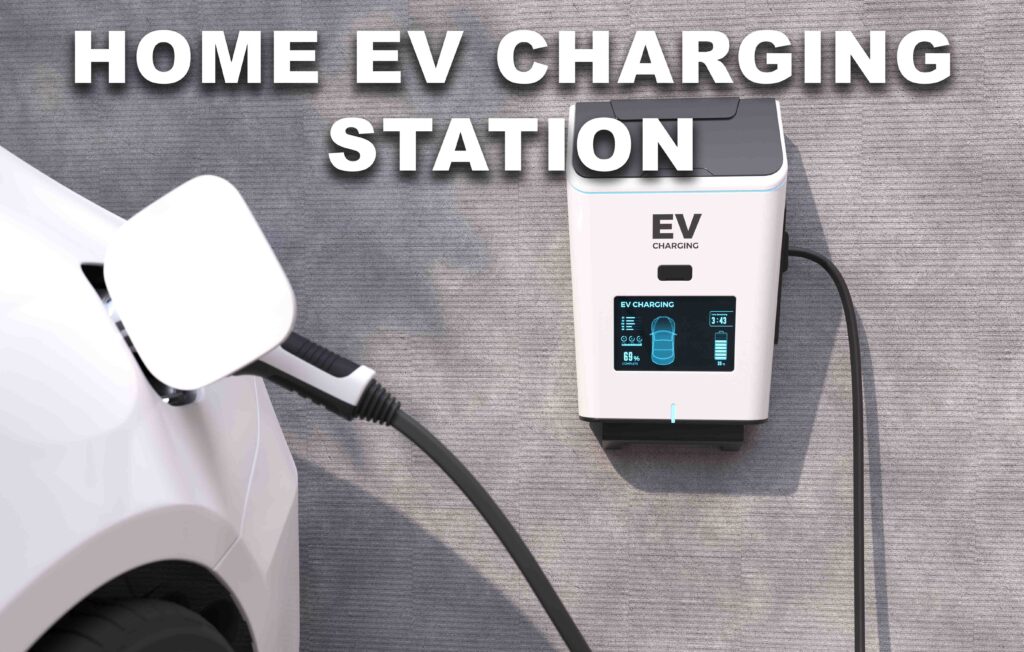The popularity of electric vehicles (EVs) has skyrocketed in recent years, thanks to growing environmental concerns and technological advancements. But to enjoy the benefits of owning an electric car, one crucial component is often overlooked: the home EV charging station. This article provides a comprehensive overview of everything you need to know about installing, using, and maintaining a home EV charging station.
Introduction to Home EV Charging Stations
A home EV charging station enables EV owners to conveniently recharge their vehicles at home. Unlike public charging stations, which may be far from your home or workplace, a private charger provides consistent, immediate access to power. Home chargers are designed to be easy to use, efficient, and, above all, safe.
How Home EV Charging Stations Work
Home EV charging stations function similarly to any other household appliance. They draw electricity from your home’s electrical panel and deliver it to your EV’s battery. There are several types of chargers, but understanding the various charging levels is essential for determining the right solution for your needs.
Understanding Electric Vehicle Charging Levels
Electric vehicle chargers come in three main levels:
- Level 1 Charging: Level 1 chargers use a standard 120-volt outlet and provide a slow charge. These chargers are typically included with the EV purchase.
- Level 2 Charging: Level 2 chargers require a 240-volt outlet, providing a faster charge that’s well-suited for overnight charging.
- Level 3 DC Fast Charging (Home Integration): Though less common for home use, Level 3 chargers offer rapid charging, but they typically require a more complex electrical setup.
Types of Home EV Charging Stations
When it comes to home EV charging stations, there’s no one-size-fits-all solution. The type of charging station that’s best for you depends on factors like your vehicle’s charging requirements, the layout of your home, and your budget. Below are the most common types of home EV chargers, each offering distinct advantages for different needs.
Wall-Mounted Charging Stations
Wall-mounted EV chargers are among the most popular options for homeowners, offering a fixed, reliable charging solution that’s permanently installed in a garage or on an exterior wall. They typically come with a charging cable and connector, and are designed to deliver Level 2 charging, which provides significantly faster charging times than the standard Level 1 option that comes with most electric vehicles.
- Advantages:
- Convenience: Once installed, the charger is always ready for use, requiring no setup before each charging session.
- Faster Charging: Wall-mounted stations usually deliver Level 2 charging, which can charge an EV 3-5 times faster than a standard household outlet.
- Aesthetic and Space Saving: Mounted neatly on a wall, these chargers save space and avoid the clutter of cables lying on the floor.
- Drawbacks:
- Installation Costs: Professional installation is required, especially if your home’s electrical system needs upgrading.
- Limited Flexibility: Once installed, you cannot easily move the charging station to a different location.
Portable EV Chargers for Home Use
Portable EV chargers offer flexibility, allowing you to charge your vehicle at home or take the charger with you on trips. These chargers typically plug into standard outlets but can also come with adapters for Level 2 charging if a 240-volt outlet is available.
- Advantages:
- Portability: Since the charger is not fixed to a wall, you can easily move it between different locations, such as using it in a vacation home or sharing it with others.
- Easy Setup: No professional installation is required for most portable chargers, making it an affordable and convenient option for many EV owners.
- Dual Use: Portable chargers can be used both at home and on the road, adding flexibility if you frequently travel or don’t always have access to a public charging station.
- Drawbacks:
- Slower Charging Times: Many portable chargers only offer Level 1 charging, which is much slower than Level 2 alternatives.
- Manual Setup: You’ll need to connect and disconnect the charger each time, which can be less convenient compared to a permanently mounted solution.
- Durability Concerns: Since portable chargers are moved around frequently, they may be more prone to wear and tear compared to a stationary charger.
Smart Home EV Charging Stations
Smart EV chargers are the latest innovation in home charging technology, offering a range of advanced features that can make charging more efficient, cost-effective, and environmentally friendly. These chargers connect to your home’s Wi-Fi and allow you to monitor and control your charging remotely via a smartphone app.
- Advantages:
- Optimized Charging: With smart chargers, you can schedule your vehicle to charge during off-peak electricity hours, saving on energy costs.
- Remote Monitoring: The ability to start, stop, or monitor charging sessions from a mobile device ensures that you have full control over your vehicle’s charging cycle, no matter where you are.
- Energy Management: Some smart chargers can integrate with home energy systems, like solar panels, allowing you to prioritize renewable energy or manage the overall power load in your home.
- Data Tracking: Many smart chargers offer insights into your charging habits, such as how much electricity you’re using and the cost per session, helping you make smarter decisions about energy usage.
- Drawbacks:
- Higher Costs: Smart chargers tend to be more expensive than basic wall-mounted units due to the added technology and features.
- Wi-Fi Dependency: The advanced features of smart chargers rely on a stable internet connection, which could be an issue if your Wi-Fi is unreliable.
- Complexity: The range of features may be overwhelming for users who are looking for a simple plug-and-play solution.
Solar-Powered EV Charging Stations
For homeowners who have solar panels installed, a solar-powered EV charging station can be an excellent way to make your EV even more environmentally friendly. These chargers connect to your home’s solar power system and use energy generated from the sun to charge your vehicle.
- Advantages:
- Zero-Emission Charging: By using solar energy, you can significantly reduce the carbon footprint of your EV charging, making the entire process sustainable.
- Energy Independence: With solar-powered charging, you’re less dependent on the grid and can avoid higher electricity costs during peak hours.
- Long-Term Savings: While the initial setup cost can be high, using free solar energy can save a substantial amount on energy bills over time.
- Drawbacks:
- High Initial Cost: Installing solar panels and an integrated charging station can be expensive upfront, although incentives and rebates can help reduce the cost.
- Weather Dependent: Solar charging is less effective in cloudy or rainy weather, potentially requiring backup electricity from the grid.
Plug-and-Play Charging Stations
Plug-and-play EV chargers are simple, no-frills chargers that don’t require professional installation. These chargers typically come with a cord that plugs directly into a standard wall outlet. While they are usually limited to Level 1 charging, they are easy to use and don’t require any modifications to your home’s electrical system.
Limited Features: These chargers don’t come with smart features or advanced energy management options.
Advantages:
Affordability: These chargers are typically the most affordable option, making them a great choice for those on a tight budget.
Ease of Use: Simply plug the charger into an available outlet, and you’re ready to charge your vehicle.
No Installation Required: Since these chargers plug into existing outlets, there’s no need for any complex installation process.
Drawbacks:
Slow Charging: Most plug-and-play chargers offer Level 1 charging only, which can take many hours to fully charge a vehicle.
Wall-Mounted Charging Stations
Wall-mounted chargers are the most popular option for homeowners. They are installed on a wall, often in a garage or driveway, and provide fast, convenient charging.
Portable EV Chargers for Home Use
Portable chargers are compact and can be plugged into any compatible outlet. These are ideal for people who need a flexible charging solution.
Smart Home EV Charging Stations
Smart chargers offer advanced features, including scheduling, remote monitoring, and energy usage reports, which can help you optimize charging times and reduce electricity costs.
Installation Process for a Home EV Charging Station
The installation of a home EV charging station involves several steps, from evaluating your electrical capacity to finding the right installer.
Assessing Electrical Requirements
Before installing a charger, you’ll need to check if your electrical system can handle the additional load. Most Level 2 chargers require a 240-volt outlet, which may necessitate an electrical upgrade.
Hiring a Licensed Electrician
For safety reasons, it’s recommended to hire a licensed electrician to install your charger. They will ensure that the charger is installed correctly and complies with local codes.
Installation Costs and Incentives
Installation costs vary based on your location, electrical setup, and the type of charger you choose. Fortunately, many governments and utility companies offer incentives, such as rebates or grants, to reduce the cost.
Benefits of Installing a Home EV Charging Station
There are numerous advantages to having your own home EV charging station, from convenience to long-term savings.
Convenience of Charging at Home
With a home charger, you can plug in your car at any time, saving you the hassle of finding public stations.
Cost Savings and Efficiency
Charging at home is usually cheaper than using public stations, especially when you take advantage of lower electricity rates during off-peak hours.
Environmental Benefits
Charging your EV at home allows you to use renewable energy sources like solar power, significantly reducing your carbon footprint.












